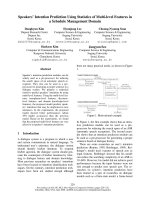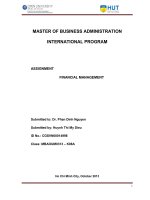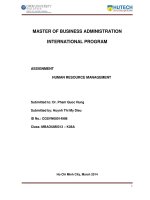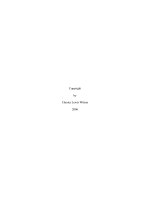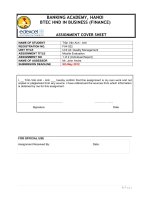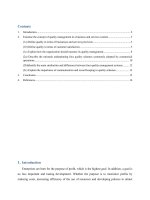statistics of management assignment 1
Bạn đang xem bản rút gọn của tài liệu. Xem và tải ngay bản đầy đủ của tài liệu tại đây (1.99 MB, 44 trang )
<span class="text_page_counter">Trang 1</span><div class="page_container" data-page="1">
NAME : PHAM THI MINH CHICLASS: BA15101TEACHER: LE PHUOC CUU LONG
STATISTICS OF MANAGEMENT ASSIGNMENT 1
Da Nang, October 2021
</div><span class="text_page_counter">Trang 2</span><div class="page_container" data-page="2">Qualification BTEC Level 5 HND Diploma in Business
Unit number and
title <sup>Unit 31: Statistics for management</sup>
Submission date October 27,2021 <sup>Date</sup> <sup>Received</sup> <sup>1st</sup>submission
Date Received 2ndsubmission
Student Name Pham Thi Minh Chi Student ID BDBF190029
Student declaration
I certify that the assignment submission is entirely my own work and I fully understandthe consequences of plagiarism. I understand that making a false declaration is a formof malpractice.
Student’s signature
Grading grid
</div><span class="text_page_counter">Trang 3</span><div class="page_container" data-page="3">Resubmission Feedback:
Internal Verifier’s Comments:
Signature & Date:
</div><span class="text_page_counter">Trang 4</span><div class="page_container" data-page="4">Table of content
I. Introduction... 1 II. Statistics methodology in business and economic... - 2 -
-1.The nature and process of business and economic data/information from arange of different published sources... - 2 -
1.1 Data, information, and knowledge... 2 1.2 How data can be turned into information and information intoknowledge... - 3 -2. Evaluating data from a variety of sources using different methods of analysis.- 8 -
2.1 Descriptive, exploratory, and confirmatory... 8 2.2 The strengths and weaknesses of every analysis method through yourabove examples...- 12 -2.3 The differences in application between methods of descriptive,exploratory, and confirmatory analysis of business and economic data. - 16 -3. Analyzing and evaluating qualitative and quantitative raw business data froma range of examples using appropriate statistical methods... - 18 -
3.1 The differences between qualitative and quantitative raw data analysis. 18 3.2 The differences between population and sample of inferential statistics.- 22 -3.3 The descriptive statistics for this dataset...- 24 -4. Evaluate the differences in application between descriptive statistics,inferential statistics and measuring association... - 32 -III. Conclusion...- 34 -IV. References... - 35 -
</div><span class="text_page_counter">Trang 5</span><div class="page_container" data-page="5">-List of figure
Figure 1: An example of a data set with numerical attributes... 2
Figure 2: Smartphone sales decline/growth in Q1 2020... 3
Figure 3 : Example 1 : DIK model... 4
Figure 4 : Example 2 : DIK model ...6
Figure 5 : Example 3 : DIK model...7
Figure 6 : Final exam score of a class...9
Figure 7 : The revenue and profit after tax of Vinacafe Bien Hoa over the years...10
Figure 8 : Biti's ads appear at a relatively high level on: TV, newspapers, socialnetworks ...26
Figure 9: Meaningful slogan, bringing credibility to customers about the company'sproducts... 27
Figure 10 : The logo is outstanding, impressive and easy to distinguish from otherbrands ...28
Figure 11: Selling price of mid-range and below product lines...29
Figure 12: The attitude of the sales staff ...30
Figure 13:The brand has a strong position in the hearts of consumers...31
Figure 14: Do you think that most Vietnamese people know Biti's brand through over39 years of development? ...32
Figure 15: The differences between descriptive statistics and inferentialstatistics ...33
</div><span class="text_page_counter">Trang 6</span><div class="page_container" data-page="6">Table 3: The final exam score of a statistics class on a 100-point scale ...8
Table 4 : Frequency, Relative Frequency, Percent Frequency (%)... 9
Table 5 : The differences between methods of descriptive, exploratory, andconfirmatory analysis... 16
Table 9: Product information for 10 tablet computers... 21
Table 10 : Example about population and sample... 23
Table 11 : Ratio (%) , Mean , Median ,Mode , Range, Variance, Standard deviation forquestion 1...25
Table 12 : Ratio (%) , Mean , Median ,Mode , Range, Variance, Standard deviation
</div><span class="text_page_counter">Trang 7</span><div class="page_container" data-page="7">Table 16: Ratio (%) , Mean , Median ,Mode , Range, Variance, Standard deviation
for question 6 ...30
Table 17: Ratio (%) , Mean , Median ,Mode , Range, Variance, Standard deviation forquestion 6 ...31
</div><span class="text_page_counter">Trang 8</span><div class="page_container" data-page="8">Statistics is an indispensable tool in research and practical work. Today, the use ofstatistics has expanded far beyond the first starting point of serving the government.Organizations and individuals use statistics to understand data and make decisions.The use of any statistical method is correct only when the study population satisfiesthe necessary mathematical assumptions of the method. Companies today havebeen applying statistical methods in business to make statistics of resources andinformation systems. My company is planning to improve decision-making andinformation management through statistical methods. As a research analyst. I amrequired to demonstrate my understanding by evaluating and analyzing businessdata through transformative statistical methods.
Main purposes
This report aims report is to analyze and evaluate business and economicdata/information using several statistical methods.
Structure of the work
In this report, I will first analyze the nature and processes of business and economicdata/information from different sources. Some definitions of data, information, andknowledge will be given. In addition, the way data can be turned into informationand information into knowledge will be analyzed through examples. Next, I willevaluate data from various sources using three analytical methods (Descriptive,exploratory, and confirmatory). Then, I will outline the strengths and weaknesses ofthese three methods. A table comparing the differences between the threeanalytical methods will also be provided. Next, I will analyze and evaluate qualitativeand quantitative raw business data from a series of examples using appropriatestatistical methods.
</div><span class="text_page_counter">Trang 9</span><div class="page_container" data-page="9">1. The nature and process of business and economic data/information from arange of different published sources.
1.1 Data, information, and knowledge.1.1.1 Data
Data are the facts and figures collected, analyzed, and summarized for presentationand interpretation. All the data collected in a particular study are referred to as thedata set for the study.( Anderson, D.R ,et al.,2016)
Data includes expressions used to reflect the reality of the research subject. Most ofthese manifestations are measured or observed values of the research variables.These expressions include numbers, words, or images ( Hoang, T. and Chu NguyenMong, N., 2008)
All these expressions, if put in a non-specific context, will not make sense. So, fordata to make sense, it must be placed in a specific context for that data to makesense.
Example : An example of a data set with numerical attributes
</div><span class="text_page_counter">Trang 10</span><div class="page_container" data-page="10">Information is the result of processing, arranging, and organizing data so that thereader has more understanding and knowledge. In other words, it is the content ofthe collected data.( Hoang, T. and Chu Nguyen Mong, N., 2008)
Information is a concept that has many different meanings, from everyday life to thetechnical environment. Generally speaking, the concept of information is closelyrelated to the constraints of information, communication, control, data, form,instruction, understanding, meaning, thought stimulation, forms, perception, andpresentation ( Hoang, T. and Chu Nguyen Mong, N., 2008)
1.1.3 Knowledge
Knowledge is what is known. Like other related concepts such as truth, belief, andwisdom. There is no single definition that is agreed upon by all scholars, but thereare many different and still debated theories. about the nature of knowledge.Knowledge accumulation is a complex cognitive process: perception, learning,communication, association, and reasoning. The term knowledge is also used toimply certain knowledge about something, which can be used to accomplish acertain goal.( Hoang, T. and Chu Nguyen Mong, N., 2008)
1.2 How data can be turned into information and information into knowledge.
1.2.1 Example 1:Smartphonesalesdecline/growthinQuarter1 2020
Figure2:Smartphonesalesdecline/growth inQ12020Sources:Krishna,S,2020
</div><span class="text_page_counter">Trang 11</span><div class="page_container" data-page="11">case they are all significant.
The data we collect is the decline/growth in smartphone sales in Quarter 12020 of 5brands: Xiaomi, Apple, OPPO, Huawei, Samsung. After the process of sifting andprocessing the collected data, we know that out of the 5 phone brands, only Xiaomiemerged as the only brand that can record sales growth. On the other hand,Samsung, Huawei, Apple, and OPPO, the other four brands in the industry's top 5suppliers for Q1 2020 - recorded a decline in sales, with a double-digit drop for mostof these brands.
The knowledge we can draw is that Samsung, Huawei, Apple, and OPPO phonecompanies need to evaluate their business situation and develop an effectivebusiness strategy for sales to grow again.
Figure3:Example1 :DIKmodel
</div><span class="text_page_counter">Trang 12</span><div class="page_container" data-page="12">in the exams in 2018 and 2017
Table1:Statistical tableofthenumberof candidatesachieving10pointsin theexamsin2018and2017
Sources:LaborNewspaper,2018The numbers
2,0,103,3,16,2,11,32,308,477,281,1,996,75,1521,401,107,603,250,4235 areconsidered as data.
The data we collect is the number of candidates who scored 10 in subjects in 2018and 2017. After screening and processing data, the information we have is that the
Number of 10 pointsin the national highschool exam in 2018
Number of 10 pointsin the national highschool exam in 2017
</div><span class="text_page_counter">Trang 13</span><div class="page_container" data-page="13">significantly reduced compared to the 2017 national high school exam.
The knowledge we can draw is that teachers of schools across the country need tore-identify the source of knowledge that the Ministry of Education uses to makeexam questions. Then create a better lesson plan to help students have better testresults in the next test.
Sources:General StatisticsOffice
</div><span class="text_page_counter">Trang 14</span><div class="page_container" data-page="14">3.366,967 are considered data
The data we collect is “Number of international visitors to Vietnam by means oftransport in 2018 and 2019”
After the process of screening and processing data, the information we have is thatthe number of international visitors to Vietnam by means of transport in 2019increased compared to the same period in 2018.
The knowledge we can draw is that, although at the beginning of 2019 there was aCovid-19 epidemic in Vietnam. However, the number of international visitors stillcomes to Vietnam a lot. This shows that Vietnam's tourism industry is developingvery well.
Figure5:Example3 :DIKmodel
</div><span class="text_page_counter">Trang 20</span><div class="page_container" data-page="20">conducted in the respondent’s natural environments , ensuring that honest , highquality data is collected.(QuestionPro,2021)
The fifth strength is quick to perform and cheap . As the sample size is generallylarge in descriptive research, the data collection is quick to conduct and isinexpensive.(QuestionPro,2021)
The last strength is forms the basic for decision making .The data collected indescriptive research is robust and represents a large population , which makes iteasier to analyze and use for decision making. (QuestionPro,2021)
The major weakness of Descriptive analysis is limited in that they only allow you tomake summations about the people or objects you have actually measured. Youcannot use the data you have collected to generalize to other people or objects (i.e.,using data from a sample to infer the properties/parameters ) (Davis,B,2021) .Thereare no generalizations about the data, and the results aren't 100% correct.
2.2.2 Exploratory analysisStrengths
The major strength of the exploratory mode is that it permits the un- structuredexamination of data and transforms the act of data analysis from a scientific searchfor mathematical results into an artistic search for empirical patterns. It permits anymanipulation of the data, but produces results that are simple to understand.Exploratory techniques may involve sophis- ticated computer routines, but neverinvolve elaborate mathematical results. The exploratory mode brings the analystclose to the data since the results arise from the mind. Data structure is bothexposed and imposed by the analyst. The inferences made by the analyst areinformal and open to criticism. Each analyst must reach his or her own conclusionsand these conclusions are open to question by any other analyst.(Mayer, L.S., 1980)
</div><span class="text_page_counter">Trang 21</span><div class="page_container" data-page="21">The major weaknesses of the exploratory mode are that it does not yield statementsthat are inferential in the statistical sense or replicable in the scientific sense.Although the analyst uncovers patterns in the data which are suggestive ofhypotheses that could be tested in future studies, the analyst is not free to test thesehypotheses on the data used to generate them. Con- sequently, the exploratorymode is best viewed as the first step in a sequential analytic process. It suggestshypotheses which are tested in subsequent analyses. These hypotheses are oftenimproved by rough confirmatory analy- sis and finally tested by the confirmatorymode. Thus, unlike the confirmatory mode, the exploratory mode cannot standalone as a method of inquiry(Mayer, L.S., 1980)
A second weakness of the exploratory mode is that it usually benefits from moreextensive data than that required by the confirmatory mode. Pro- vided certainassumptions are made, the confirmatory mode can study aggregate units in order tomodel the behavior of individual sampling units (consumers). The exploratory modehas no provision for substituting aggre- gate for disaggregate data. Although thedata on aggregates can be explored, the exploratory analyst prefers to examine dataon individual units if the behavior of the individuals is the topic of analysis. Thispreference often leads to the gathering and management of a large amount ofdata.(Mayer, L.S., 1980)
2.2.3 Confirmatory analysisStrengths
The major strength of the confirmatory mode is that the results obtained arereplicable and optimal in well-defined areas. Given the same theory, models, andhypotheses, two investigators should obtain the same parameter estimates and thesame degree of evidence in favor of each research hy- pothesis. Ideally, their resultswould differ only to the extent that they give different substantive interpretations tothe statistical inferences made. Furthermore, should they offer different statisticalresults, then the optimality theorems of classical statistics often provide justificationfor preferring one set of results over the other. In areas such as multivariate analysis
</div><span class="text_page_counter">Trang 22</span><div class="page_container" data-page="22">obtain,the optimality and replicability of the inferences made are reduced and,consequently, the power of the confirmatory mode is impaired. In such areasstatisticians are actively searching for appropriate optimality theorems.(Mayer, L.S.,1980)
The second strength of the confirmatory mode is that it yields indicators of theuncertainty associated with its inferences. As examples, the estimated standarderror is an indicator of the uncertainty of a parameter estimate and the critical leveland power are indicators of the uncertainty associated with a hypothesis test.Without the confirmatory mode the data analyst might be able to make inferencesabout the population being sampled, but these infer- ences would be informal in thesense that no indicator of the uncertainty of the inferences could be given. Suchinferences would be significantly weaker, in the scientific sense, then the inferencesof the confirmatory mode.(Mayer, L.S., 1980)
The major weaknesses of the confirmatory mode are that it requires specification ofthe theory, models, and hypotheses prior to the examination of the data.Confrontation with data allows the analyst to modify the model and proposealternative hypotheses, but classical statistical methods are designed to provideoptimal estimators and tests and are not specifically designed to be aids in thereformulation of the theory, models, or hypotheses. Once the model and hypotheseshave been changed, confirmatory methods are not optimal for estimating the modelor testing the hypotheses. In fact, there are almost no theorems in classical statisticswhich guarantee the optimality of a confirmatory method if the model orhypotheses are re- formulated after an initial confrontation with the data.(Mayer,L.S., 1980)
</div>

